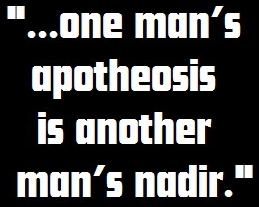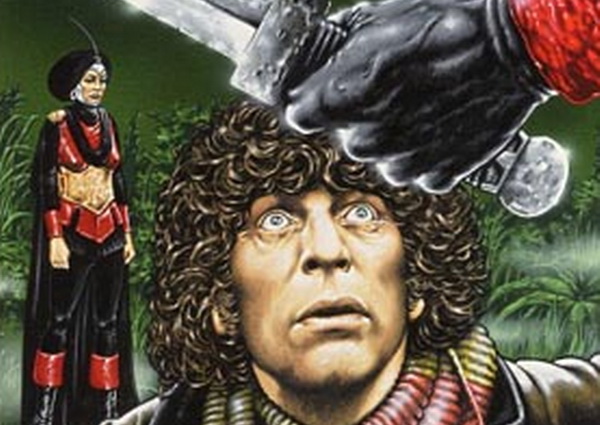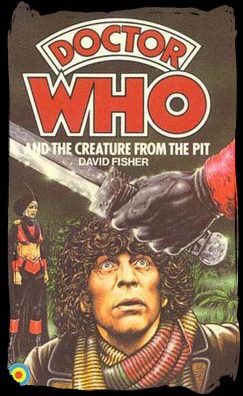|
| |
|
STORY PLACEMENT
THIS
STORY TAKES TV STORY "CITY OF
DEATH" AND THE
PRODUCTION CODE 5G
WRITTEN BY DAVID FISHER
DIRECTED BY CHRISTOPHER BARRY
RATINGS 10.0 MILLION
RECOMMENDED PURCHASE 'THE CREATURE FROM THE PIT' DVD (BBCDVD 2849) RELEASED IN MAY 2010.
BLURB MAKING A FORCED MATERIALISATION ON CHLORIS, THE DOCTOR, ROMANA AND K-9 SOON BECOME EMBROILED IN THE MACHINATIONS OF ITS RULER, THE LADY ADRASTA.
THE LUSH VEGETATION OF THE PLANET'S SURFACE HIDES A RAGTAG GROUP OF BANDITS, A GIANT EGGSHELL, MAN-EATING WOLFWEEDS AND, IN THE DEPTHS OF AN OLD MINING PIT, SOMETHING LARGE HAS A SECRET WHICH THREATENS THE DESTRUCTION OF THE ENTIRE PLANET...
RECOMMENDED PURCHASE BBC AUDIO CD (ISBN 1- 4056-876-30) RELEASED IN APRIL 2008.
BLURB Tom Baker reads THE complete, unabridged novelisation, first published by Target Books in 1981.
|
|
|
The Creature From the Pit 27th october 1979 - 17th november 1979 (4 EPISODES)
“What is that thing in the pit?” “We call it… THE CREATURE!”
If you aren’t instantly rapt by excerpt of dialogue above, then I would suspect that you aren’t likely to be impressed by The Creature from the Pit - I most certainly wasn’t. In fact, within my head this serial is waging an interminable war against the likes of Underworld and even Paradise Towers for the mantle of “worst televised story ever”, and as such I can’t say that I was terribly thrilled by the news that it was coming to DVD ahead of classics like The Tenth Planet and The Dæmons.
However, the Restoration Team have done a sterling job of presenting the four abominable episodes in the best possible light. Tom Kelly and John Daly’s notes in the accompanying booklet highlight each of the serial’s more commendable aspects, even going so far as to label it the “apotheosis of the Graham Williams / Douglas Adams era of Doctor Who”, yet at the same time acknowledging that one man’s apotheosis is another man’s nadir. This balanced approach is mirrored in all of the DVD’s special custom-made features, from the (sadly) Tom Bakerless commentary all the way up to the fifteen-minute penis post-mortem that is Team Erato.
Above: Matt Irvine recalls the witch hunts of 1979 in Team Erato
I enjoyed Team Erato, the DVD’s focus featurette, most of all. Not only does it offer candid insight into the production of late 1970s Doctor Who, but it’s actually rather suspenseful – far more so than The Creature from the Pit itself. I elected to watch this feature before I tackled the disc’s main feature, for some reason forcing my wife to watch it with me, perhaps under the delusion that she’d find what then-producer Graham Williams described as “blancmange with a four foot phallus” humorous in some way. However, the programme is structured in such a way that the eponymous creature isn’t revealed in all his phallic glory until well over half way through. Indeed, the first ten minutes or so are punctuated with cliffhanger-like clips from the serial that are cut away from before Erato is seen, building up genuine suspense and coming dangerously close to making the serial look good!
only does it contain some of the most stupendously imaginative euphemisms for knob that I’ve ever come across - director Christopher Barry’s managing to top his colleagues’ “pseudopodia” and “proboscis” with “masculine propensities”, which had me in stitches – but it also contains some blinding anecdotes. Most entertaining is Morag McLean’s, the poor woman who had to clamber inside Erato and try to at least not make him act like a cock. In the end, such was Morag’s indignation, she lost her rag and took a Stanley knife to the prop, rendering it unusable!
More substantial though is a charming documentary that sees Christopher Barry look back on his long and fascinating life. Filmed on location in Wiltshire village of Aldbourne, where his masterpiece The Dæmons was shot, these twenty minutes cover everything from Quakers, aeroplanes and location caterers all the way through to Daleks, Dæmons and pit-dwelling creatures with masculine propensities. Of course, Doctor Who doesn’t get a mention until round about the half-way mark, but I suppose that this is forgivable given that the man wasn’t born directing Daleks, despite what most of us assume.
The disc also contains a couple of interesting little titbits. There’s a twenty-two second extended scene, which is nice to have for posterity, but that isn’t really worthy of note (I’ve spent longer typing this sentence than I did watching it). The Animal Magic clip is a minute and a half longer and, once I’d got past my disillusionment at the lack of polar bears and lions featured, really quite enjoyable. Although the Animal Magic people had blatantly nobbled Baker between takes and stuck him in front of an autocue, it’s still fun to watch his eyes pop out of his head as he describes the Fendahl sucking the life out of people and all manner of recently-encountered alien nasties doing their thing. Erato doesn’t get a mention though, tellingly.
“To be honest I did have a couple of gadgets that he probably didn’t, like a teaspoon and an open mind.”
Turning to the four cleaned-up episodes of The Creature from the Pit, I’m afraid that even when muffled by Lalla Ward’s reminiscences, they’re still calamitous, boasting an effective jungle set, but very little else. If I’m in the right sort of mood, I can forgive bland and insipid, but this serial is downright embarrassing from start to finish. David Fisher’s script is full of great ideas that are vitiated by appalling execution – we even have the Doctor wandering around talking to himself for long sequences, a device that is barely pardonable on audio, let alone on telly. And even if one could blind themselves to the fact that the amorphous blob of the title clearly isn’t an amorphous blob, but the Jolly Green Giant’s cock and balls, there is no getting past the hammy performances of Myra Frances (Lady Adrasta) and Unbound Doctor Geoffrey Bayldon (Organon). To be fair to both performers, the script didn’t really give them any option but to ham it up... but then again, they didn’t have to take the parts!
Tom Baker’s performance, meanwhile, is typical of this period in his tenure - outrageously silly with the odd flash of genius. At times – when he is wrapping his terrible tongue around some blatant Douglas Adams one-liners, for the most part – he manages to be rather droll, but the rest of the time he’s just being pure, unfettered Baker which does tend to ruin certain scenes that I’m sure were intended to be quite solemn. It’s a great pity that Williams and his appointed directors weren’t able to sieve Baker’s performances in the same way that Philip Hinchcliffe’s production team could. Whilst the fourth Doctor wouldn’t be the fourth Doctor without Baker’s idiosyncratic little flourishes, in stories like this one where he’s allowed to just run amok the whole production suffers.
Believe it or not though, I do have a positive comment to make about this sorry serial - Lalla Ward is absolutely dazzling in it. The Creature from the Pit was the first story that she filmed as the newly-regenerated Romana and, despite having to find her feet, she still managed to steal the show with her bravura display of savvy and steel. I particularly love the scene where she commands the heavily armed bandits to “sit,” and they obey. Even this early on, it isn’t hard to believe that this incarnation of Romana went on to rule Gallifrey.
All told, The Creature from the Pit DVD is a surprisingly enjoyable
affair, its balanced bonus material making equal allowance for those that
love it and those that... um... don’t. As you’ve probably gathered, I’m
firmly in the latter camp, and if I haven’t put you off this serial by
now, then you deserve everything that you get.
|
|
|
Copyright © E.G. Wolverson 2007, 2010
E.G. Wolverson has asserted his right under the Copyright, Designs and Patents Act, 1988 to be identified as the author of this work. |
|
|
BBC7’s short run of fourth Doctor audios comes to a close with David Fisher’s novelisation of his own television script, The Creature from the Pit. I doubt that the original serial makes it to many fans’ lists of favourites; it’s one of those jobbing, perfectly average stories that isn’t at all bad, but isn’t anything to get excited over either. It’s also one that is often remembered more for its embarrassing monster costume than anything in the actual story. The fact that neither Earth or Gallifrey, or anyone we’ve ever heard of, are threatened also means it tends to get overlooked among stories where the Doctor saves humanity or, indeed, the entirety of creation itself.
Stripped of its green bin bag beast and some rather dodgy performances, The Creature from the Pit really isn’t a bad story. It may not be a poll-topper, but it does have plenty of virtues. The central conceit is an intriguing one: a world overrun with vegetation but poor in metals comes into contact with a being from a world with precisely the opposite problems. Fisher’s novelisation, though generally sticking to the story as televised, adds lots of quirky bits of local flavour in an attempt to bring the two worlds to life. Sadly, the situation on the former world, Chloris, isn’t explored to any great degree or much logic. The outcome is simply that there’s one ruling party with a monopoly on what little metal there is, while some clichéd bandits try to steal and trade with what little is left. Frankly, the commodity could’ve been anything at all. A terrestrial planet with virtually no metal content would be so utterly unlike our own that the life forms there would have evolved to exist in a very different way to what we’re familiar with.
are depicted with more thought. Although we never visit the world, the musings and memories of the eponymous creature, Erato, conjure up an intriguing picture. His is an extremely advanced species, having developed well beyond the need for what he considers easily-breakable and unnecessary body parts, a species that now spends its considerable life span dedicated to music, art, poetry and idle chat. Fisher expands on the original problem of the world, revealing that it’s the Tythonians unique reproductive cycle that requires the extra plant matter. A process that takes twenty thousand years to complete, Tythonian naughties result in six inch long larvae which require a steady supply of chlorophyll to mature - a supply that has now run dry.
It’s perhaps no surprise then that Erato is the most intr- iguing character in the book, a sullen yet sympathetic beast who struggles to speed his thought processes up enough to communicate with these flimsy humanoids. The villains of the piece, Lady Adrasta and her sidekick Karela, are a little one note, although fairly good fun in a panto kind of way. It’s also a rarity to have female villains in the series, although, interestingly, all three of the novels adapted for this radio series have included one (Miss Winters in The Giant Robot, Maren in The Brain of Morbius). Organon is a great character though, getting some of the best lines in the story, and works extremely well even without Geoffrey Bayldon’s spirited performance. Tom Baker clearly has a way with these mad professor / wizard types. Far less successful are Torvin and his hairy-faced bandits, their stereotypically offensive Jewish accents faithfully reproduced for us here by Baker. The narrator once again rises to the challenge of providing distinctive voices for the various characters, though, and his callous booming Adrasta is quite marvellous. The best voices, however, are those treated electronically, such as the warbling Erato and the enjoyably camp K-9. Oddly, Baker is seemingly unable to pronounce Tythonus the same way twice in succession. The production standard is high, with Simon Power providing some excellent music and tropical sound effects that give Chloris far more life than learning that the fondle is the local equivalent of the turkey.
Reviewers often point out the Douglas Adams-y vibe to Fisher’s prose, and,
although I think it has been overstated, the influence of his former
script editor is clear. The gentle humour helps keep the fairly pedestrian
plot kicking along. The final two chapters provide perhaps the best
moments. In the original serial, the coda, involving the threat of a
Tythonian neutron star on a collision course with Chloris, seems
enormously rushed. Here, it’s given room to breathe and comes across as a
potent threat.
However, the
science on offer is still terribly dodgy in any medium. Still, it’s good
to have a less-remembered story brought to a wider audience, and just in
time for the original serial’s immanent DVD release.
|
|
|
Copyright © Daniel Tessier 2010
Daniel Tessier has asserted his right under the Copyright, Designs and Patents Act, 1988 to be identified as the author of this work. |
|
|
Unless otherwise stated, all images on this site are copyrighted to the BBC and are used solely for promotional purposes. ‘Doctor Who’ is copyright © by the BBC. No copyright infringement is intended. |
|

.jpg)
.jpg)
.jpg)
.jpg)
.jpg)
 Team
Erato
Team
Erato.jpg)
.jpg)
.jpg)
.jpg)

 It’s
the people of Tythonus that
It’s
the people of Tythonus that 